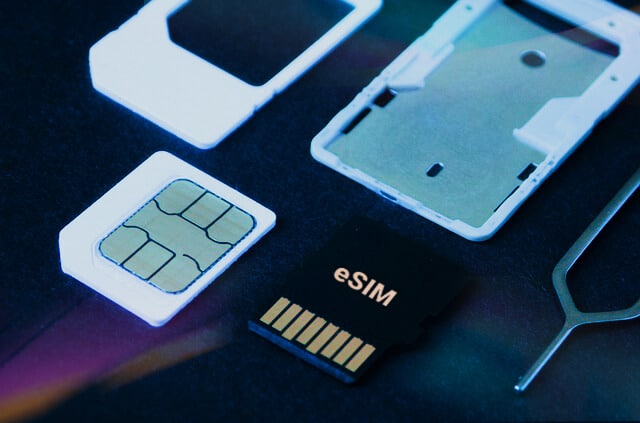In today’s hyper-connected world, seamless global connectivity is the key that unlocks boundless opportunities for exploration, innovation, and growth. As artificial intelligence (AI) continues to revolutionize industries, its true potential can only be realized when combined with cutting-edge connectivity solutions.
Enter the world of embedded SIMs (eSIMs) – a game-changing technology that promises to reshape how we experience the digital world, especially for travel enthusiasts seeking adventure and cultural immersion.
Setting the Stage: AI’s Impact on Connectivity

AI has made significant strides in enhancing connectivity, from optimizing network performance to predicting and mitigating outages. Global enterprises are harnessing AI’s power, with 22% of firms aggressively integrating AI across diverse technology products and business operations. Integrating AI is crucial, as it enables the handling of complex tasks, such as assessing vast amounts of imaging data, which would otherwise be arduous for humans.
However, for AI to truly thrive, it requires seamless, global connectivity – a challenge that traditional SIM cards struggle to meet. This is where eSIMs come into play, offering unparalleled flexibility and paving the way for innovative business models.
The Rise of eSIMs: Streamlining Global Connectivity
eSIMs, or embedded SIMs, are revolutionizing the way devices connect to cellular networks. Unlike traditional SIM cards, which require physical swapping, eSIMs are built directly into devices, enabling them to switch between networks without any physical intervention. This seamless transition is a game-changer for globetrotters, digital nomads, and anyone seeking uninterrupted connectivity while traversing international borders.
The eSIM market is expected to top $16.3 billion by 2027, according to Juniper Research, a testament to its rapidly growing adoption. Imagine the convenience of having your phone, laptop, or wearable device automatically connect to the best available network as you explore new destinations, without the hassle of juggling multiple SIM cards. Discover more here about how eSIMs can enhance your travel experiences.
Moreover, eSIMs are ushering in new business models, such as pay-per-use data plans and network-agnostic service providers. This flexibility not only caters to the diverse needs of travelers but also paves the way for innovative IoT solutions, smart city initiatives, and enterprise connectivity solutions.
AI’s Role in Enhancing eSIM Functionality
While eSIMs offer unparalleled flexibility, their true potential is unlocked when integrated with AI algorithms. By leveraging AI, eSIMs can intelligently select the best network based on location, network conditions, and user preferences, ensuring a seamless and optimized connectivity experience.
Dynamic Network Selection
AI algorithms can continuously monitor and analyze various factors, such as:
- Signal strength
- Network congestion
- User behavior patterns
to make informed decisions about which network to connect to. This dynamic network selection process ensures that devices remain connected to the most reliable and efficient network, minimizing disruptions and maximizing performance.
Predictive Analytics and Failover
Moreover, AI-based analytics can provide real-time insights into connectivity performance, predicting network outages or latency issues before they impact users. By analyzing vast amounts of data from multiple sources, including:
|
Source |
Example |
|---|---|
|
Network performance metrics |
Latency, throughput, packet loss |
|
Weather patterns |
Storms, atmospheric conditions |
|
Social media activity |
Reports of outages or service disruptions |
AI can identify potential disruptions and proactively trigger failover mechanisms or re-route traffic to alternative networks.
Seamless Connectivity for Travelers
This predictive capability is invaluable for travelers, ensuring they can stay connected even in remote or challenging environments. Whether you’re trekking through a remote hiking trail or navigating a bustling city, AI-powered eSIMs can predict connectivity issues and proactively maintain a stable connection.
Robust Security and Fraud Prevention
Furthermore, AI plays a crucial role in enhancing the security of eSIM-enabled devices, protecting user data, and preventing fraud. With the proliferation of IoT devices and the increasing reliance on cloud-based services, robust security measures are essential, especially for travelers carrying sensitive information or conducting business on the go.
AI-powered security solutions can analyze vast amounts of data to detect anomalies, identify potential threats, and implement countermeasures in real-time. From identifying suspicious network traffic patterns to detecting and mitigating malware attacks, AI can provide a multi-layered defense against cyber threats, ensuring the integrity and confidentiality of user data.
Innovative Use Cases: Where AI-Driven eSIM Connectivity Shines
The synergy between AI and eSIM technology opens up a world of possibilities across various industries, but for travel enthusiasts, adventure seekers, and culture buffs, the benefits are particularly compelling.
1. Consumer Electronics:
Wearable devices and tablets can seamlessly connect to local networks as you explore new destinations, providing real-time translations, augmented reality experiences, and personalized recommendations tailored to your interests.
AI-powered virtual assistants can leverage eSIM connectivity to offer context-aware recommendations, such as suggesting local restaurants or cultural attractions based on your preferences and location.
2. Automotive Industry:
For adventure seekers embarking on road trips or off-road explorations, eSIM-enabled vehicles with AI-powered telematics can offer real-time navigation, predictive maintenance, and emergency assistance in remote areas.
AI algorithms can analyze vehicle data, road conditions, and weather patterns to optimize routes, predict potential breakdowns, and automatically request assistance.
3. Enterprise Solutions:
Businesses can leverage eSIM technology and AI to optimize global supply chains, monitor IoT devices in real-time, and minimize downtime, ensuring uninterrupted operations regardless of location.
AI-powered analytics can monitor sensor data from IoT devices, predict maintenance needs, and automatically trigger service requests or reroute shipments to avoid delays.
4. Smart Cities:
As cities embrace digitalization, eSIM-powered IoT devices combined with AI can revolutionize urban infrastructure, from optimizing traffic flow and energy usage to enhancing public safety and emergency response.
AI algorithms can analyze real-time data from connected devices, such as traffic cameras and air quality sensors, to dynamically adjust traffic signals, reroute vehicles, and optimize resource allocation.
5. Tourism and Hospitality:
Travel companies can leverage AI-driven eSIM connectivity to offer personalized experiences and real-time assistance to their customers.
AI-powered virtual concierges can provide tailored recommendations, booking assistance, and even language translation services, enhancing the overall travel experience.
These examples demonstrate how AI-driven eSIM connectivity can reshape travel and exploration, empowering individuals and businesses to navigate the world confidently and effortlessly. As technology continues to evolve, new and innovative use cases will undoubtedly emerge, further solidifying the synergy between AI and eSIM technology.
Future Trends: What Lies Ahead
As the adoption of eSIMs continues to surge across emerging markets and industries, we can expect several transformative trends to shape the future of this technology:
1. Software-Defined Networking: The integration of AI and eSIMs will accelerate the shift towards fully software-based network management, enabling real-time optimization and seamless switching between carriers and networks.
2. Disruption in Telecommunications: Traditional telecom providers will face increased competition from network-agnostic service providers, potentially leading to more consumer-centric pricing models and innovative service offerings.
3. Privacy and Regulation: As connectivity becomes increasingly ubiquitous, concerns around data privacy and security will grow, prompting the need for robust regulations and industry standards to protect user rights.
4. Global Connectivity Standards: The widespread adoption of eSIMs and AI-driven connectivity solutions will necessitate the development of global standards, ensuring interoperability and fostering a unified, borderless connectivity experience.
While the future holds exciting possibilities, it is essential to navigate these trends proactively, addressing potential challenges and embracing the opportunities that lie ahead.
Frequently Asked Questions
Q1: How will eSIM technology impact traditional telecom providers, and what changes can consumers expect?
Traditional telecom providers will face increased competition from network-agnostic service providers enabled by eSIM technology. Consumers can expect more flexibility in choosing service plans, potentially leading to more consumer-centric pricing models and innovative service offerings tailored to their needs.
Q2: What security challenges could arise from the integration of AI and eSIMs, and how can they be mitigated?
As connectivity becomes more ubiquitous and data-driven, concerns around data privacy and security will grow. Robust encryption protocols, user authentication measures, and industry-wide security standards will be crucial in mitigating these challenges. Additionally, AI-powered security solutions can proactively detect and prevent potential threats.
Q3: Will the adoption of eSIMs and AI create a more fragmented or unified global connectivity environment?
While the initial stages of eSIM adoption may introduce some fragmentation due to varying standards and provider models, the long-term goal is a unified global connectivity environment. The development of industry-wide standards and the adoption of network-agnostic service providers will foster interoperability and a borderless connectivity experience for users worldwide.
Key Takeaways
The convergence of AI and eSIM technology is poised to revolutionize how we experience the world, fostering seamless global connectivity and unlocking a realm of innovative possibilities.
Whether you’re a travel enthusiast seeking authentic cultural experiences, an adventure seeker embarking on off-the-beaten-path explorations, or a history buff exploring ancient wonders, AI-driven eSIM connectivity promises to be your trusted companion, ensuring uninterrupted access to the digital world while you immerse yourself in the wonders of the physical one.










